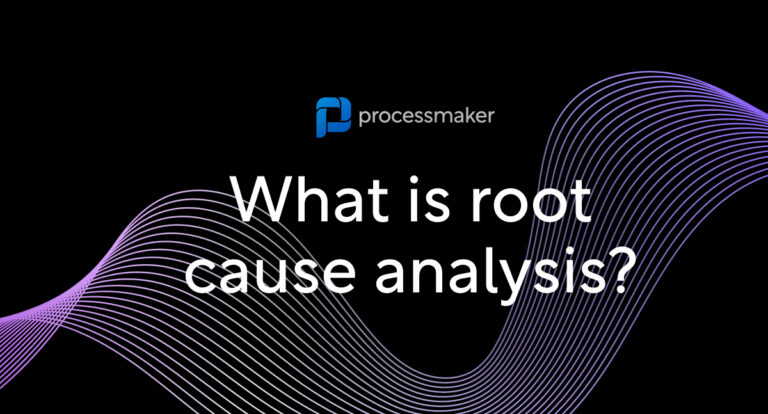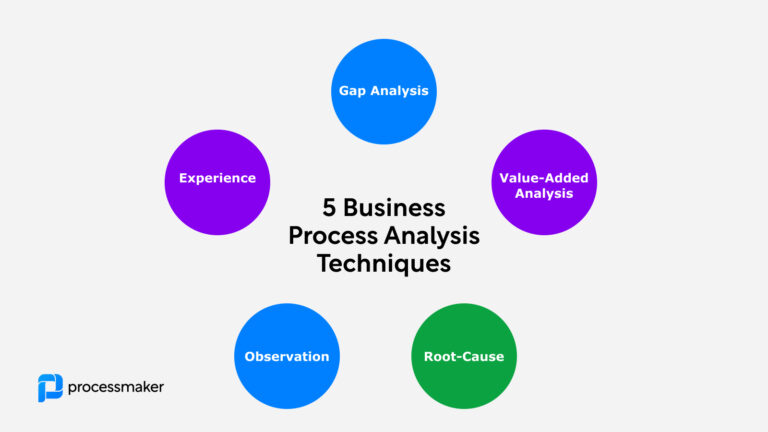The root cause analysis process is an effective problem-solving tool that helps to identify the main cause of an issue. In data science and engineering, it is used to identify the actual root causes of a problem and devise an effective solution. In this simply explained guide, we will look at the steps of root cause analysis, provide examples, and discuss common pitfalls.
What is root cause analysis in business processes?
Root cause analysis is the process of discovering the underlying key causes of business problems to identify appropriate solutions. Performing root cause analysis is crucial for diagnosing underlying problems, developing corrective actions, and preventing future issues through a systematic analysis process. It is widely used in IT and business operations, manufacturing, and process mining.
Root cause analysis can be seen as the discovery of the core causes of business problems
Importance of root cause analysis in BPM
Root cause analysis is a key component of business process management (BPM) because it helps organizations identify and address the underlying issues causing problems within their processes. By pinpointing these root causes, companies can make lasting improvements that lead to increased efficiency, effectiveness, and profitability.
Here are some reasons why RCA is important in BPM:
- Identify and fix core problems. RCA aids in identifying the core issues that may be affecting a business process, rather than focusing on the symptoms or superficial problems. This allows for a more thorough understanding of the situation and the factors contributing to the problem.
- Consider contributing factors. In addition to identifying root causes, RCA also examines contributing factors that may influence the occurrence of a problem. This comprehensive approach enables teams to develop more effective corrective actions.
- Identify causal factors. RCA employs analytical techniques and tools like the 5 Whys and Fishbone Diagram to identify causal factors, distinguishing them from root causes. This helps in mapping out the events and conditions leading to a problem.
- Prevent failures and bottlenecks. By identifying the root causes of issues, organizations can implement corrective actions that prevent the recurrence of similar problems in the future. This proactive approach helps to improve the overall stability and efficiency of business processes.
- Continuous Improvement. RCA is an essential aspect of continuous improvement, which is a key principle of BPM. By constantly analyzing processes for root causes of problems, organizations can make incremental changes that lead to significant long-term improvements in performance and productivity.
- Reduce costs. Addressing the root causes of problems often leads to cost savings, as it reduces the need for temporary fixes, rework, or additional resources to manage ongoing issues. By optimizing processes and eliminating waste, companies can achieve more with less.
- Improve customer satisfaction. Improving business processes by addressing root causes can lead to a better customer experience. Efficient processes result in timely delivery of products and services, fewer errors, and improved quality, all of which contribute to higher customer satisfaction.
- Identify sources of competitive advantage. Companies that consistently perform root cause analysis and address underlying issues are better positioned to stay ahead of their competitors. By continually improving processes and resolving problems, businesses can adapt more quickly to changing market conditions and maintain a competitive edge.
- Improve employee satisfaction. When employees understand the importance of RCA and participate in the process, they are more likely to feel engaged and committed to the organization’s success. Involving employees in problem-solving activities can foster a culture of continuous improvement and shared accountability.
In summary, root cause analysis is an essential aspect of business process management, as it helps organizations identify and address the underlying issues affecting their processes. This leads to improved efficiency, cost savings, increased customer satisfaction, and a competitive edge in the market.
Steps of root cause analysis
Root cause analysis can be broken down into six steps.
- Identifying the problem: the first step is to clearly define the problem. This should be done in a concise manner that clearly outlines the issue.
- Gathering data: the next step is to gather data related to the issue. This can include documents, interviews, or any other data that can help to identify the root cause.
- Analyzing data: once the data has been gathered, it should be analyzed to identify patterns or trends that may be related to the issue. Identifying the causal factor is crucial in this step to differentiate between direct contributors and underlying root causes.
- Identification of root causes: once the data has been analyzed, the root causes can be identified. This is the key step of the process, as it is the root cause that must be addressed in order to solve the problem. Fault tree analysis can be a valuable tool here, using a logical structure to map out events leading to the fault.
- Developing solutions: once the root causes have been identified, solutions can be developed to address the issue.
- Implementing solutions: the final step is to implement the solutions and ensure that the issue has been fully resolved.
5 whys method and fault tree analysis for root cause analysis
The 5 Whys method is a simple and effective root cause analysis technique often used in problem-solving and continuous improvement initiatives. It was developed by Sakichi Toyoda, the founder of Toyota Industries, and later became an essential part of the Toyota Production System. The technique is based on the principle of asking “Why?” five times to identify the root cause of a problem.
The 5 Whys method follows these basic steps:
- Define the problem: Clearly state the issue you are trying to address. It’s important to have a well-defined problem statement to ensure that everyone involved in the analysis understands the scope of the investigation.
- Ask “Why?”: Once the problem is defined, ask “Why did this happen?” to determine the immediate cause of the issue. This first “Why?” question should focus on understanding the direct cause of the problem.
- Continue asking “Why?“: After identifying the immediate cause, ask “Why?” again to uncover the underlying causes. Continue this process of asking “Why?” and finding answers until you reach the root cause of the problem. This usually happens within five iterations, but it could be more or less, depending on the complexity of the issue.
- Identify root cause: The root cause is the fundamental reason behind the problem, and addressing it will prevent the issue from recurring. Keep in mind that there may be multiple root causes, depending on the complexity of the problem.
- Implement corrective actions: Once the root cause(s) has been identified, develop and implement corrective actions to address the issue and prevent it from happening again. Monitor the effectiveness of these corrective actions and adjust as necessary to ensure the problem is fully resolved.
The 5 Whys method can be a straightforward approach to root cause analysis that can be applied to a wide range of problems. It is particularly useful for relatively simple issues, but can also be used as a starting point for more complex investigations. By repeatedly asking “Why?” and seeking answers, the method helps organizations identify the underlying causes of problems and implement lasting solutions.
Examples of root cause analysis and contributing factors
Root cause analysis can be used in a variety of industries and contexts. Here are a few examples:
- Healthcare: Root cause analysis can be used in healthcare to identify the cause of medical errors and develop solutions to prevent them.
- Manufacturing: Root cause analysis can help to identify the cause of production issues and develop solutions to increase efficiency.
- Services: Root cause analysis can be used to identify and solve problems related to IT services, such as software or hardware issues.
- Risk Analysis: Root cause analysis can be integrated with Failure Mode and Effects Analysis (FMEA) to proactively identify vulnerabilities and potential failures in processes, quantifying the severity and likelihood of issues to guide preventive measures.
Common pitfalls of root cause analysis
While root cause analyses are powerful problem-solving tools, there are a few common pitfalls to be aware of.
- Focusing on the symptoms. It is important to avoid focusing on the symptoms of the problem and instead focus on the root cause.
- Not collecting enough data. It is important to collect enough data to ensure that the root cause is accurately identified.
- Being too quick to implement solutions. It is important to take the time to develop effective solutions that address the root cause.
- Too much focus on a happy path. In business process improvement, you often have an idealized ‘happy path’ describing how processes should work that is not tied to the reality of complex business organizations.
Conclusion
Root cause analysis is a powerful problem-solving tool that can help organizations quickly identify and solve issues. By breaking down the process into six steps, organizations can ensure that they are effectively identifying and addressing the root cause of the issue. Additionally, it is important to be aware of common pitfalls, such as focusing on the symptoms, not collecting enough data, and being too quick to implement solutions. By following these steps and avoiding common pitfalls, organizations can ensure they are effectively using root cause analysis to solve problems.
FAQs:
1. What should a RCA include?
A root cause analysis (RCA) can take many shapes but should always include 1. A problem definition, 2. Data collection, 3. cause identification and 4. corrective actions needed.
2. What are the 5 Whys of RCA?
The Five Whys of root cause analysis is a problem-solving technique that involves asking “Why?” multiple times (typically five) to identify the root cause of a problem. The Five Whys process starts by defining the problem and then asking “Why?” to uncover the immediate cause. The questioning continues, exploring underlying causes until the root cause is identified. The goal of this method is to determine the fundamental reason behind the issue so that effective corrective actions can be implemented to prevent recurrence.
3. How does root cause analysis relate to Six Sigma?
Root cause analysis (RCA) can be used as part of Six Sigma methodologies to identify and address the sources of variability and problems in processes. RCA is a key component of the Define, Measure, Analyze, Improve, and Control (DMAIC) process used in Six Sigma to optimize and improve business processes. The Analyze phase of DMAIC often incorporates RCA techniques to determine the root causes of process defects, inefficiencies, or variability, which enables the implementation of data-driven solutions to achieve lasting improvements.
4. What are the different types of root cause analysis software?
Different types of root cause analysis software include:
- Cause-and-effect diagram software (e.g., Fishbone or Ishikawa diagrams): These tools help visualize the relationships between potential causes and the problem being investigated.
- Fault tree analysis software: This type of software is used to analyze complex systems and identify potential failure points by modeling the relationships between various events and their probabilities.
- Event tree analysis software: This tool is used to model the possible outcomes and consequences of an initiating event in order to understand the chain of events that could lead to the problem.
- Failure Modes and Effects Analysis (FMEA) software: FMEA software assists in the systematic identification and assessment of potential failure modes in a process, product, or system, helping prioritize corrective actions based on their severity, occurrence, and detection ratings.
- Incident investigation and management software: These tools provide a structured approach for collecting, organizing, and analyzing data related to incidents and near misses, often including built-in RCA methodologies and reporting capabilities.
- Task mining and process mining software. These tools help identify key bottlenecks or points of failure in business processes and key workflows.





